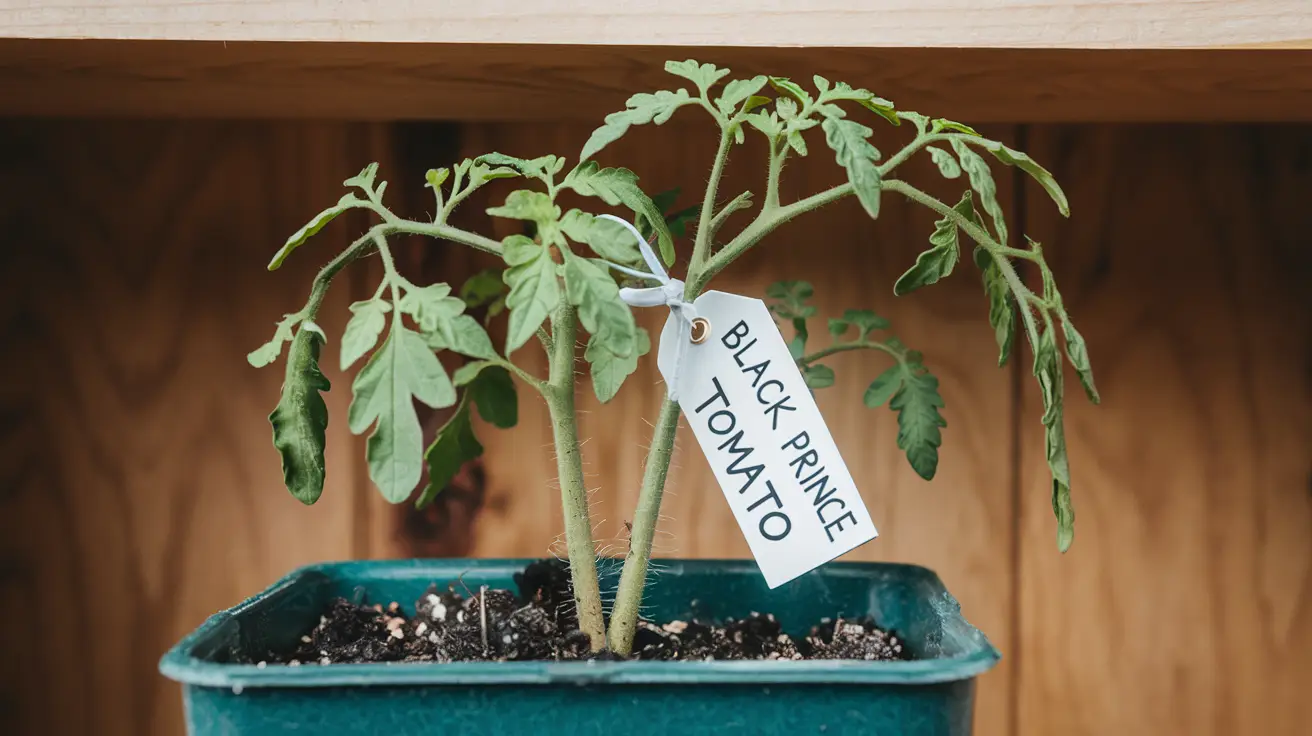Table of Contents
Black Prince tomato growing requires special care and attention to achieve the best results.
The Black Prince tomato is a beloved heirloom variety known for its dark, rich color and deep flavor. This type of tomato, originating from Siberia, is particularly popular among organic gardeners due to its adaptability to cooler climates and resistance to diseases. Whether you’re a novice or an experienced gardener, this step-by-step guide will help you successfully grow Black Prince tomatoes, from planting to harvest.
Black Prince Tomato Growing: Ideal Conditions
Black Prince tomatoes are prized for their unique appearance and taste. Unlike common red tomatoes, these are maroon to purplish-black in color, making them a standout addition to any garden or table. Known for their sweet, slightly smoky flavor, they are ideal for fresh salads, sauces, and even roasting.
This variety is an indeterminate tomato, meaning it continues to grow and produce fruit throughout the growing season. If you live in a region with cooler temperatures, this tomato is a great choice because of its ability to thrive in lower light and warmth, compared to other tomato varieties.
Ideal Growing Conditions for Black Prince Tomatoes

To ensure your Black Prince tomatoes grow strong and healthy, it’s essential to understand the optimal conditions for this unique variety.
Soil Preparation and Fertility
Black Prince tomatoes prefer well-draining soil rich in organic matter. The soil should have a pH between 6.0 and 6.8, which is slightly acidic. Before planting, mix in compost or well-rotted manure to boost nutrient content. This helps ensure the plants receive the necessary nitrogen, phosphorus, and potassium for robust growth.
For more details on soil preparation, visit the University of Minnesota Extension
Light, Temperature, and Watering Needs
Black Prince tomatoes thrive in full sun, requiring at least 6 to 8 hours of sunlight per day. However, they are more tolerant of partial shade and cooler temperatures compared to other tomato varieties, making them a great choice for gardeners in northern climates.
Ideal temperatures for growing range between 70°F and 85°F (21°C to 29°C). Nighttime temperatures should not drop below 50°F (10°C), as cooler temperatures can stunt growth or damage the plant.
Watering is crucial for tomato growth. Aim to keep the soil consistently moist but not waterlogged. Deep watering once or twice a week is better than light, frequent watering. Be sure to water at the base of the plant to avoid wetting the foliage, which can lead to fungal diseases.
For additional watering best practices, visit the Royal Horticultural Society (RHS)
Planting and Care Instructions

Proper planting and ongoing care are essential for ensuring your Black Prince tomatoes thrive and produce abundant fruit.
Starting from Seed or Transplanting Seedlings
You can start Black Prince tomatoes from seeds or purchase seedlings from a nursery. If starting from seed, begin indoors about 6-8 weeks before the last expected frost in your area. Sow seeds in small pots filled with a quality seed-starting mix and place them in a warm location. Keep the soil moist until germination, which usually takes 5-10 days.
For more insights on seeding tomatoes in specific climates, you can refer to this guide: Is It Too Late to Seed Tomatoes in 9A Texas?.
Once seedlings have developed their second set of leaves, transplant them into larger containers or a garden bed. Space plants 18 to 24 inches apart to allow for proper air circulation and growth.
Staking and Supporting Tomato Plants
Black Prince tomatoes, being indeterminate, grow tall and require support to prevent the stems from breaking under the weight of the fruit. Use stakes, cages, or trellises to provide support. Stakes should be about 6-8 feet tall, driven into the ground at the time of planting to avoid disturbing the root system later.
As the plant grows, gently tie the main stem to the stake using soft plant ties or cloth strips. Regularly check the ties and adjust them as the plant grows to avoid constriction.
Dealing with Common Issues
Even with proper care, tomatoes can encounter various problems. Below are some common issues and how to manage them.
Pest and Disease Prevention
Black Prince tomatoes are relatively disease-resistant, but like all tomatoes, they can be susceptible to certain pests and diseases. Aphids, tomato hornworms, and whiteflies are common pests. To control these pests, try introducing beneficial insects like ladybugs, which feed on aphids, or use organic insecticidal soap sprays.
For more organic pest control methods, check out Rodale Institute
Fungal diseases such as early blight or powdery mildew can also affect tomato plants. To prevent these diseases, practice crop rotation and avoid planting tomatoes in the same spot year after year. Water plants at the base, keeping the foliage dry, and prune lower leaves to improve air circulation around the base of the plant.
Troubleshooting Common Problems
Some common problems Black Prince tomatoes might face include:
- Blossom End Rot: This is caused by a calcium deficiency, often due to inconsistent watering. To prevent this, ensure the soil remains evenly moist and consider using a calcium-rich fertilizer.
For more information on preventing blossom end rot, see the University of California Agriculture & Natural Resources
For additional tips on managing calcium deficiencies, you can also refer to: Unlock the Power of Calcium Carbonate in Your Garden.
Harvesting Black Prince Tomatoes
After months of care, it’s time to harvest your Black Prince tomatoes. Knowing when and how to pick your tomatoes ensures you get the best flavor and quality from your crop.
When and How to Harvest
Black Prince tomatoes typically mature in 70 to 80 days after planting. They will turn a deep maroon color when fully ripe. However, the color alone isn’t the only indicator—gently squeeze the fruit, and if it gives slightly, it’s ready for harvest.
Harvest by gently twisting or using scissors to cut the stem above the fruit. Avoid pulling the tomatoes, as this can damage the plant.
Post-Harvest Care and Storage
After harvesting, store Black Prince tomatoes at room temperature, out of direct sunlight. Avoid refrigeration, as this can affect the flavor. If you have an abundance of ripe tomatoes, you can also consider preserving them by canning, drying, or freezing for later use.
For further details on storing fresh tomatoes, refer to the National Center for Home Food Preservation
FAQs about Growing Black Prince Tomatoes
1. How long does it take for Black Prince tomatoes to mature?
Black Prince tomatoes typically mature in 70 to 80 days after planting. The fruits will turn a deep maroon color and will feel slightly soft when gently squeezed, indicating they are ripe.
2. Can Black Prince tomatoes be grown in containers?
Yes, Black Prince tomatoes can be grown in containers, provided the container is large enough to accommodate the plant’s root system. Use a container that holds at least 5 gallons of soil and ensure it has adequate drainage.
3. How often should I water Black Prince tomatoes?
Black Prince tomatoes should be watered deeply once or twice a week, depending on the weather. Ensure the soil remains consistently moist but not waterlogged. Water at the base of the plant to avoid wetting the foliage, which can lead to disease.
4. What type of fertilizer should I use for Black Prince tomatoes?
A balanced, organic fertilizer that is high in phosphorus and potassium is ideal for Black Prince tomatoes. Avoid too much nitrogen, as it can lead to excessive foliage growth at the expense of fruit production.
5. How do I prevent blossom end rot in Black Prince tomatoes?
Blossom end rot is usually caused by a calcium deficiency and inconsistent watering. To prevent it, ensure the soil stays evenly moist and add calcium-rich amendments, such as crushed eggshells or bone meal, to the soil.
6. Are Black Prince tomatoes good for colder climates?
Yes, Black Prince tomatoes are an excellent choice for cooler climates due to their Siberian origins. They are more tolerant of cooler temperatures compared to other tomato varieties, making them a great option for gardeners in northern regions.
Conclusion
Growing Black Prince tomatoes is a rewarding experience that leads to a delicious and versatile crop. By following this comprehensive guide on Black Prince tomato growing, from soil preparation and planting to proper care and harvesting techniques, you can ensure a bountiful harvest of these unique and flavorful heirloom tomatoes. Whether you are an experienced gardener or just starting, following best practices in Black Prince tomato growing will help you enjoy the full potential of this exceptional variety in your garden.




Pingback: How to Grow red yucca plant - CropTap: Your Ultimate Gardening Guide
Pingback: black prince tomato growing: Tips & Tricks
Pingback: Top 10 Purple Tomatoes Varieties: Vibrant and Unique
Pingback: Square Tomato Cages: Support Your Garden's Growth